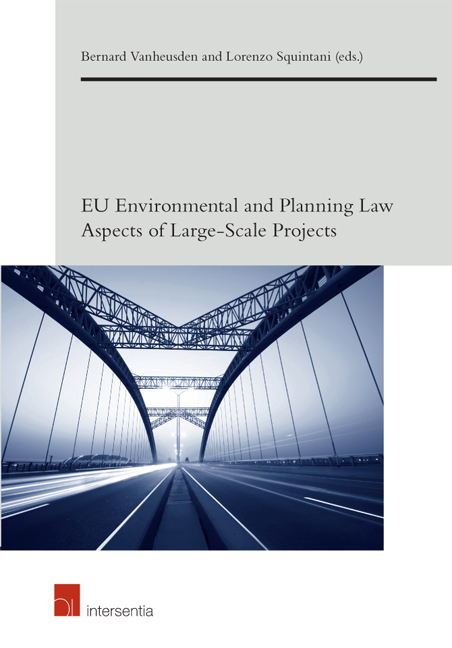Book contents
- Frontmatter
- Contents
- Introduction
- Part I General
- Part II Public Participation
- Part III Environmental Impact Assessment
- Part IV Water
- Chapter 10 The Case for Smart Governance in European Water Law
- Chapter 11 Coal-Fired Power Plants under EU Water Law: The Phasing-Out Requirement of Priority Hazardous Substances – An Obstacle to the Permission of Coal-Fired Power Plants?
- Chapter 12 The Permissibility of Projects for Interbasin Water Transfer under the Prism of the EU Water and Environmental Legislation
- Part V Nature
- Part VI Land Use
- Conclusion: Reconciling Conflicting Values: A Call For Research on Instruments to Achieve Quasi-Sustainability
Chapter 12 - The Permissibility of Projects for Interbasin Water Transfer under the Prism of the EU Water and Environmental Legislation
from Part IV - Water
Published online by Cambridge University Press: 21 September 2018
- Frontmatter
- Contents
- Introduction
- Part I General
- Part II Public Participation
- Part III Environmental Impact Assessment
- Part IV Water
- Chapter 10 The Case for Smart Governance in European Water Law
- Chapter 11 Coal-Fired Power Plants under EU Water Law: The Phasing-Out Requirement of Priority Hazardous Substances – An Obstacle to the Permission of Coal-Fired Power Plants?
- Chapter 12 The Permissibility of Projects for Interbasin Water Transfer under the Prism of the EU Water and Environmental Legislation
- Part V Nature
- Part VI Land Use
- Conclusion: Reconciling Conflicting Values: A Call For Research on Instruments to Achieve Quasi-Sustainability
Summary
INTRODUCTION
One of the overriding problems of the 21st century is that of the protection and the sustainable use of the scarce water resources, which is intensified due to the climate-induced changes on water ecosystems. Population growth, economic activities, such as industry and agriculture that presuppose an increased use of water, and increasing urbanisation are, among others, significant drivers for an over-exploitation of the water resources in many regions, which often results in shortages of water availability.
In such circumstances, demand-oriented measures are not entirely sufficient. Supply-oriented measures are also considered to be possible solutions to increasing water demand in areas which are not able to live within their ecological limits. Interbasin water transfers (IBTs) are regarded as one of the most prominent supply oriented solutions for coping with the above-described situations. For the purposes of this chapter, the term of ‘interbasin water transfer’ refers to the transfer of water from one river basin to another through the development of the necessary infrastructure, that includes, inter alia, the construction of dams, pipelines and reservoirs. Since the implementation of such projects presupposes large-scale and significant interventions, the consequences arising from their realisation can be far-reaching not only from an environmental but also from a social and an economic point of view.
The main aim of the chapter is to answer the central question of whether EU water law and EU environmental law in general provide either concrete rules or at least certain clear-cut criteria and other relevant instruments for assessing the permissibility of the IBTs as a possible solution for satisfying water demand in water-stressed regions. In this context, it should be clarified that although EU water law can be predominantly viewed as a specific field of the EU environmental law, it has a certain level of autonomy in relation to the latter for reasons relating mainly to the specificity of its content, its strong transboundary dimensions and its interdependencies with international water law. On the basis of this remark, in the framework of this chapter the provisions of the EU water law are analysed separately from those of the EU environmental law. Moreover, it is worth noting that the chapter is inspired by the ‘Acheloos case’, namely a long-term and controversial case, which relates to the plans for the diversion of the relevant river through a composite project.
- Type
- Chapter
- Information
- Publisher: IntersentiaPrint publication year: 2016



